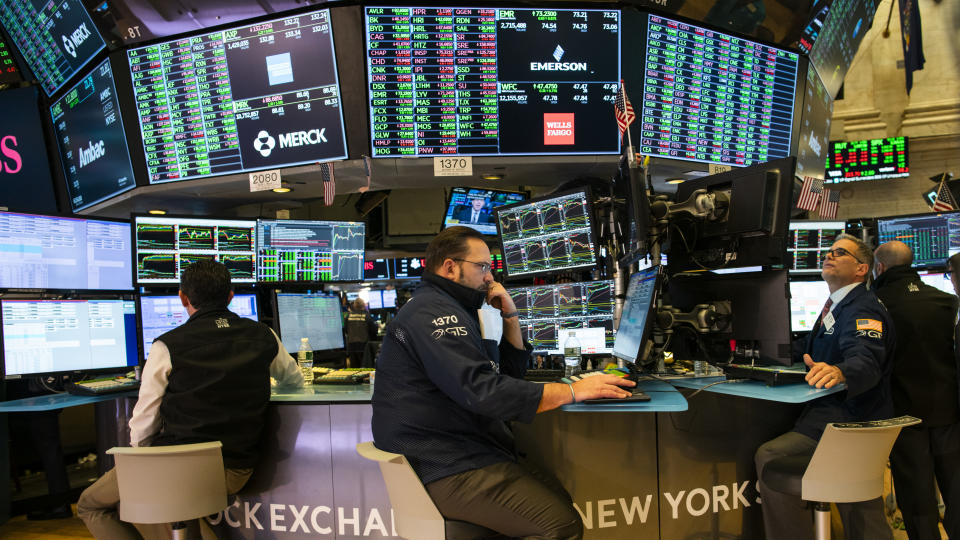Stock market news live: S&P 500, Nasdaq narrowly eke out record closes
U.S. stocks closed Friday’s session mixed, as investors continued to monitor developments with the coronavirus, and digested economic data including January retail sales and a gauge of consumer sentiment.
—
4:14 p.m. ET: Stocks end mixed as coronavirus fears linger;
U.S. stocks closed out Friday’s session little changed, with both the S&P 500 and Nasdaq narrowly eking out record closes. The Dow remained slightly in the red.
Here’s where the markets settled at the end of regular equity trading:
S&P 500 (^GSPC): +0.18% or +6.22 points to 3,380.16
Dow (^DJI): -0.09% or -25.23 points to 29,398.08
Nasdaq (^IXIC): +0.2% or +19.21 points to 9,731.18
Crude oil (CL=F): +1.24% or +0.64 to 52.06 a barrel
Gold (GC=F): +0.44% or +6.90 to 1,585.70 per ounce
—
2:53 p.m. ET: Trump administration considering tax incentives to encourage Americans to buy stocks: CNBC
The White House is considering including tax incentives in a new package proposal to encourage Americans to purchase more stocks, CNBC said in a report, citing unidentified people familiar with the matter.
One such proposal under consideration could see a portion of household income be treated as tax-free when used to invest outside a traditional 401(k), the report said.
American household ownership of stocks has fallen to 52% from 62% after the Great Recession, according to Gallup.
—
1:40 p.m. ET: Coronavirus warnings on the rise, but still early: Factset

With the coronavirus’ impact on Corporate America growing, Factset dug into the earnings season data. The firm found that 138 companies have discussed the virus on earnings calls, with the average revenue exposure to the country being 7.2%.
For all S&P 500 Index (^GSPC) companies, that figure is less than 5%, and many companies have said it was too soon to gauge the effect:
While many of these 138 companies discussed the current negative impact or the potential future negative impact of the coronavirus on their businesses, 47 companies (or 34%) stated during their earnings call that it was too early (or difficult) to quantify the financial impact or were not including any impact from the coronavirus in their guidance. On the other hand, 34 companies (or 25%) included some impact from the coronavirus in their guidance or modified guidance in some capacity due to the virus.
Given the large number of companies that did not update or modify guidance due to the impact of coronavirus, it is possible that there will be an increase in the number companies issuing negative guidance later in the first quarter as these companies gain clarity on the impact of the coronavirus on their businesses.
—
12:00 p.m. ET: Stocks mixed, Dow turns negative
U.S. stocks were mixed intraday Friday, struggling for direction amid a mixed print on retail sales and ongoing concerns over the coronavirus.
Here were the main moves in markets, as of 12:00 p.m. ET:
S&P 500 (^GSPC): +0.11% or +2.58 points to 3,377.52
Dow (^DJI): -0.06% or -18.61 points to 29,404.70
Nasdaq (^IXIC): +0.22% or +19.77 points to 9,731.74
Crude oil (CL=F): +1.28% or +0.66 to 52.08 a barrel
Gold (GC=F): +0.36% or +5.70 to 1,584.50 per ounce
11:35 a.m. ET: ‘Exceptionally high’ uncertainty clouding oil, Goldman says
In a research note to clients on Friday, Goldman Sachs doesn’t expect oil to break $65 this year, largely because of the demand hit from the raging coronavirus epidemic:
Fundamental uncertainty in the oil market is exceptionally high. The loss of Chinese and global oil demand from the coronavirus outbreak is significant but remains unknown in both scale and duration while the timing and scale of a potential OPEC+ production cut remains highly uncertain as well.
The market is currently awash in supply, which is helping to keep prices low, and underscores how critical China and emerging markets are to “smoothing out supply and demand shocks,” the firm’s analysts write:
Mapping the residual OECD inventory path to our pricing model points to a gradual recovery in oil prices from current levels with Brent prices of $53, $57, $60 and $65/bbl for the rest of 1Q through 4Q20 vs. our prior $63/bbl forecast (with WTI $4.5/bbl lower).
Crude traded over 1% higher in Friday’s dealings (CL=F) to around $52 per barrel.
—
11:30 a.m. ET: Cole Haan files to go public

There’s a shoe quip in here somewhere: The fashionable footwear company (which used to be part of the Nike (NKE) family has filed paperwork for an initial public offering. The move makes official a confidential filing Cole Haan made last year, but didn’t disclose offering size and price info.
—
10:00 a.m. ET: Consumer sentiment comes in higher than expected in February
Consumer sentiment rose more than expected in February, according to the University of Michigan’s advance February consumer sentiment index.
The headline index rose to 100.9 for the month, above the 99.5 expected by consensus economists. In January, the headline index had clocked in at 99.8. This was near this expansion’s recent peak of 101.4 from March 2018.
The subindex tracking consumers’ sentiment about future expectations also beat expectations, coming in at 92.6 versus the 90.0 expected. However, the subindex gauging sentiment about current conditions missed slightly, coming in at 113.8 versus the 114.0 expected.
Amid the buoyancy of February’s results, consumers have begun on the periphery to mention political and geopolitical concerns, according to the University of Michigan’s chief economist Richard Curtin.
“These gains in consumers' economic assessments have also been accompanied by a faint stirring of two powerful sources of uncertainty. First, the coronavirus was mentioned by just 7% when asked to explain their economic expectations in early February,” Curtin said. “Second, the runup to the presidential election is likely to focus on the vast changes to taxes and spending programs; in early February, only 10% of all consumers mentioned some aspect of the election as having a potential impact on their economic expectations.”
—
9:32 a.m. ET: Stocks open slightly higher amid coronavirus, economic data
U.S. stocks opened mixed Friday morning after a mixed print on January retail sales growth and as coronavirus cases continued to rise.
Here were the main moves in markets, as of 9:34 a.m. ET:
S&P 500 (^GSPC): +0.17% or +5.87 points to 3,379.81
Dow (^DJI): +0.11% or +32.07 points to 29,455.38
Nasdaq (^IXIC): +0.27% or +26.59 points to 9,737.7
Crude oil (CL=F): +1.44% or +0.74 to 52.16 a barrel
Gold (GC=F): +0.25% or +3.90 to 1,582.70 per ounce
—
8:30 a.m. ET: Retail sales growth matches expectations in January, but clothing store sales fall sharply
Headline retail sales rose by 0.3% in January, the Commerce Department said Friday, matching consensus expectations. This was slightly faster than December’s downwardly revised 0.2% increase for overall retail sales.
Sales in the retail sales control group, which excludes autos, gas, building materials and food services, were flat in January. In December, core retail sales were downwardly revised to a 0.2% rise, from the 0.5% gain previously reported. This category mostly closely aligns with the consumer spending component of gross domestic product.
Clothing stores and retailers reported a sales decline of 3.1% in January, the most since 2009. Electronics stores, health and personal care stores and gas stations also posted more modest declines in sales.
Miscellaneous store retailers led sales growth with a 2.3% advance in January. Sales at building material and garden equipment and supplies dealers were up 2.1%.
—
7:56 a.m. ET: Delta Air Lines says it will invest $1 billion to limit its carbon footprint over the next decade
Delta Air Lines is earmarking $1 billion over the next decade to help limit the environmental impact of air travel with the goal of becoming the first globally carbon neutral airline, the company said in a statement Friday. The company is the first airline to make a commitment of that magnitude to improving the environmental impact of its operations.
The aviation industry accounts for about 2% of global carbon dioxide emissions, according to Delta. Its planned changes include improving flight operations to decrease the use of jet fuel, investing in new technology to remove carbon emissions from the atmosphere, and working with other stakeholders to further its carbon reduction goals.
"There's no greater challenge that I know of that we need to be investing and innovating in than environmental sustainability,” CEO Ed Bastian told CNBC Squawk Box Friday morning.
—
7:38 a.m. ET: Stock futures drift higher in early trading
U.S. stock futures recovered some of Thursday’s losses ahead of the opening bell, holding higher even as traders eyed developments with the coronavirus.
Overnight, the number of coronavirus cases jumped by 5,000 to more than 63,000 in China. This came a day after the country’s Hubei province changed the way it counted cases to include those diagnosed by CT imaging scans, in addition to those counted by previous nucleic acid tests.
Contracts on the Nasdaq outperformed against those for the S&P 500 and Dow in early trading, with the tech-heavy index catching a bid higher as shares of Nvidia (NVDA) rose nearly 7%. The chip-maker late Thursday delivered fourth-quarter results that topped consensus estimates, driven by record data center sales. Nvidia said it expects first-quarter sales will be $100 million lower due to impacts from the coronavirus, but its first-quarter guidance for revenue of $3 billion was still better than the Street expected.
Here were the main moves during the pre-market session, as of 7:38 a.m. ET:
S&P 500 futures (ES=F): 3,383.5, up 6 points or 0.18%
Dow futures (YM=F): 29,460.00, up 28 points or 0.10%
Nasdaq futures (NQ=F): 9,644.25, up 31.25 points or 0.33%
Crude oil (CL=F): $52.01 per barrel, up $0.59 or 1.15%
Gold (GC=F): $1,579.60 per ounce, up $0.80 or 0.05%

—
Follow Yahoo Finance on Twitter, Facebook, Instagram, Flipboard, LinkedIn, and reddit.
Find live stock market quotes and the latest business and finance news

